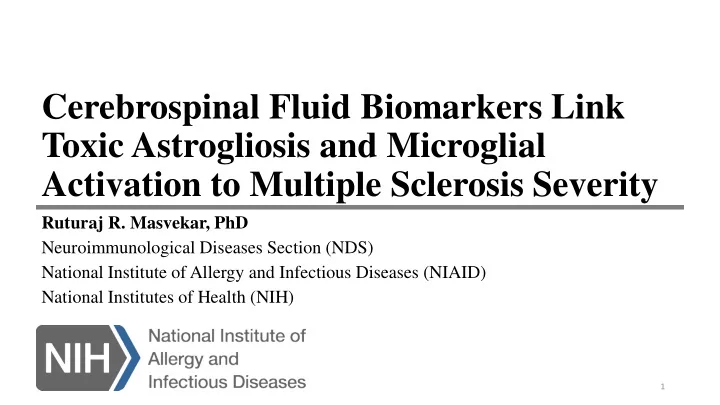

Cerebrospinal Fluid Biomarkers Link Toxic Astrogliosis and Microglial Activation to Multiple Sclerosis Severity Ruturaj R. Masvekar, PhD Neuroimmunological Diseases Section (NDS) National Institute of Allergy and Infectious Diseases (NIAID) National Institutes of Health (NIH) 1
The efficacy of immunomodulatory treatments in MS decreases with age and disease evolution Age (years) 2 Front Neurol. 2017; 8:577.
Alternative intrathecal processes underlying disability progression during late stages of MS • Mitochondrial dysfunction, ER stress, hypoxia etc. • Aberrant microglial and astroglial activation • Degeneration of oligodendrocytes • Axonal damage and neuronal apoptosis Currently we lack the biomarkers that could measure these CNS cell-specific intrathecal processes in living subjects 3
Objectives 1. Identify and validate CSF biomarkers reflective of CNS cell-specific intrathecal processes 2. Assemble related biomarkers into clusters to decrease dimensionality and to better understand biology behind them 3. Investigate whether such CNS cell type-enriched clusters differ in MS patients during disease evolution 4. Investigate whether these clusters correlate with clinical measures of disability, CNS tissue destruction and MS severity 4
Identification of CNS cell type-enriched biomarkers Primary Human Primary Human Oligodendrocytes Human Microglia Human Brain Neurons Astrocytes differentiated Cell Line Endothelial Cell Line (ScienCell) (ScienCell) from hPSCs (CHME5) (HCMEC/D3) 24 hours cell-culture supernatants Slow Off-rate Modified DNA Aptamers assay (SOMAscan; measuring 1,302 proteins) Cell type-enriched biomarker: absolute release of this protein by a specific cell type was at least 5-fold higher than the release by any other cell types 40 neuron-, 73 astrocyte-, 81 oligodendrocyte-, 18 microglia-, and 38 endothelial cell type-enriched biomarkers 5
Identification of CNS cell type-enriched biomarker clusters • Proteins that are secreted together by identical CNS cell types under identical physiological or pathological conditions will have strong correlations in the CSF samples collected from diverse group of individuals Patients’ CSF SOMAscan ( n = 431 ; HD = 42, NIND = 57, CIS = 20, RR-MS = 127, SP-MS = 72 and PP-MS = 113) Variable cluster analysis CNS cell type-enriched biomarkers CNS cell type-enriched biomarker clusters Cluster score (principal component score) 7 neuron-, 20 astrocyte-, 19 oligodendrocyte-, 7 microglia-, and 11 endothelial cell type-enriched biomarker clusters 6
Analysis of differences in cluster scores across disease diagnostic subgroups All Patients (n = 431) Training Cohort Validation Cohort (n = 217) (n = 214) Age-adjusted cluster scores compared among disease diagnostic subgroups Statistically significant differences Only statistically significant differences assessed (ANOVA; p < 0.05 ) in independent validation cohort 7
Astrocyte cluster 8 and microglia cluster 2 significantly elevated in all MS subgroups Validation Cohort Astrocyte Cluster 8 Astrocyte Cluster 8 Microglia Cluster 2 MMP7 Matrix Metalloproteinase 7 SERPINA3 Age-Adjusted Cluster Score Serpin Family A Member 3 GZMA Granzyme A CLIC1 Chloride Intracellular Channel Protein 1 Microglia Cluster 2 DSG2 Desmoglein 2 TNFRSF25 Tumor Necrosis Factor Receptor Superfamily Member 25 8
Selected clinical measures of disability, CNS tissue destruction and MS severity • Disability: • EDSS: Expanded Disability Status Scale (Discrete, 0-10) • CombiWISE: Combinatorial Weight-Adjusted Disability Scale (Continuous 0-100; Front Neurol. 2016; 7:131) Courtesy of Multiple Sclerosis Association of America • CNS tissue destruction • COMRIS-CTD: Composite MRI scale of CNS tissue destruction (Mult Scler Relat Disord. 2015; 4(6):526-35) MS Severity: how fast disability progresses • MS severity • MSSS: Multiple Sclerosis Severity Score (EDSS-based) • ARMSS: Age Related Multiple Sclerosis Severity (EDSS-based) • MS-DSS: Multiple Sclerosis Disease Severity Scale (CombiWISE-based ) (Developed using machine-learning, can predict future rates of disability progression; Front Neurol. 2017; 8:598) • CombiWISE, COMRIS-CTD and MS-DSS available free at: https://bielekovalab.shinyapps.io/msdss/ 9
Correlation analysis between cluster scores and selected clinical measures Only MS Patients (n = 312) Training Cohort Validation Cohort (n = 160) (n = 152) Analyze correlations between age-adjusted cluster scores and selected clinical measures Statistically significant correlations Only statistically significant correlations assessed (Spearman correlations; p < 0.01 ) in independent validation cohort 10
Astrocyte cluster 8 and microglial cluster 2 significantly correlated with selected clinical measures Validation Cohort Astrocyte Cluster 8 Disability CNS tissue destruction MS severity MMP7 r = 0.26 r = 0.36 r = 0.19 COMRIS-CTD Matrix Metalloproteinase 7 CombiWISE p = 0.0002 p < 0.0001 p = 0.0082 MS-DSS SERPINA3 Serpin Family A Member 3 GZMA Granzyme A CLIC1 Chloride Intracellular Channel Protein 1 r = 0.27 r = 0.36 r = 0.28 COMRIS-CTD CombiWISE p = 0.0002 p < 0.0001 p = 0.0001 Microglia Cluster 2 MS-DSS DSG2 Desmoglein 2 TNFRSF25 Tumor Necrosis Factor Receptor Superfamily Member 25 Age-Adjusted Cluster Score Age-Adjusted Cluster Score Age-Adjusted Cluster Score 11
Abnormally activated microglia induce toxic (A1) astrocytes & both are associated with MS lesions Nature. 2017; 541(7638):481-487. Immunity. 2017; 46(6):957-967. 12
Conclusions & Future Directions Abnormally Activated Microglia ? Pro-Inflammatory STOP Cytokines + Disability, CNS Tissue Destruction and MS Severity Quiescent (Resting) Toxic (A1) Astrocytes Astrocytes ? Drug Library STOP Screening 13
Acknowledgements Neuroimmunological Diseases Section (NDS) Chief: Bibi Bielekova Lab: Clinical: Chris Barbour Tiffany Hauser Paav Hannikainen Mary Sandford Kayla Jackson Alison Wichman Peter Kosa Michelle Woodland Ruturaj Masvekar Linh Pham Jon Phillips Elena Romm Mihael Varosanec Special thanks to NDS patients and their families https://www.niaid.nih.gov/research/bibi-bielekova-md 14
Questions • Poster: P281; Friday, March 1, 2019; 11:15 AM – 1:00 PM • Contacts: • Ruturaj R. Masvekar: ruturaj.masvekar@nih.gov • Bibi Bielekova: bibi.bielekova@nih.gov • Article: 15
Recommend
More recommend